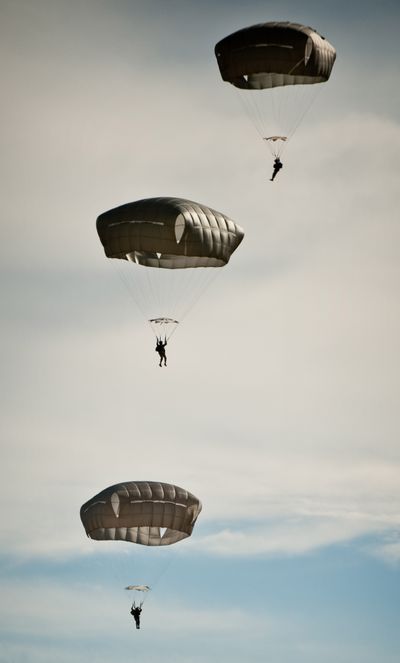Army suspends use of new parachute
Paratrooper killed jumping with square-shaped model

RALEIGH, N.C. – The Army is suspending use of its first new parachute since the 1950s after a paratrooper was killed while jumping with the updated model, which features a square-shaped canopy resembling a huge fitted bedsheet.
The T-11 parachute has been gradually replacing an older, mushroom-shaped design that has remained largely unchanged for more than five decades. The new parachute is supposed to be safer and more reliable because it has a larger canopy to slow a soldier’s rate of descent and reduce injuries from hard landings.
The suspension, announced last week, came about two weeks after Staff Sgt. Jamal Clay, 25, of Elida, Ohio, died at Fort Bragg following an apparent parachute malfunction during a routine training jump from 800 feet, a typical altitude simulating combat conditions.
After Clay’s death, investigators identified problems with the packing process for the parachutes that resulted in tangled loops, twists in the top of the canopy and improper folds that could hamper the chute’s operation.
“The observations are significant and pervasive enough to indicate potential systemic shortfalls,” according to the Army order suspending use of the T-11.
Army spokesman William Layer said the suspension was standard procedure until the military can investigate.
The investigation is being done at the Army Safety Center at Fort Rucker, Ala.
Despite Clay’s death, one manufacturer of the parachutes is confident they will prove safer and more effective for soldiers than the old T-10 model.
“In terms of the performance of the parachute itself, I’ve heard of no issues up until this point,” said Gregory Kraak, director of war fighter equipment for individual protection systems for Phoenix-based BAE Systems, one of three manufacturers supplying the Army with the new parachutes. “The data’s pretty straightforward.”
With the old parachutes, “You’re coming down faster. You’re carrying less weight. You land fairly hard, and your injury rate is higher,” said Kraak.
The improved safety that comes from softer landings even outweighed concerns that, with a slower descent, paratroopers in combat could be exposed to ground fire for longer periods of time, Kraak said.
In a February presentation to a parachute industry trade group, Army officials said the T-11 has an injury rate of around 1.1 per 1,000 jumps, compared with more than 2.7 per 1,000 jumps for the old T-10 chutes.
The new square-shaped chutes are also designed to support up to 400 pounds, about 40 pounds more than the old model. That’s important because it allows soldiers to carry more equipment into the field, Kraak said.
The Army has been slowly replacing the older model since 2009. More than 12,000 T-11s were in use by early this year. The plan is to replace all 52,000 of the old parachutes by 2017.